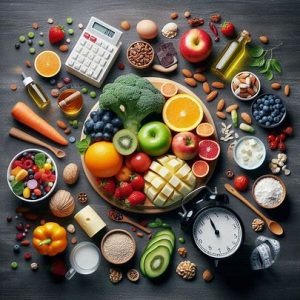Introduction
In today’s fast-paced world, where convenience foods and processed snacks dominate diets, the consumption of sugar and salt has reached alarming levels. Excessive intake of these two ingredients is linked to a host of health issues, including obesity, heart disease, diabetes, and hypertension. The World Health Organization (WHO) recommends that adults limit added sugars to less than 10% of their daily caloric intake and salt to less than 5 grams per day. Despite these guidelines, many people unknowingly exceed these limits, often due to hidden sugars and sodium in packaged foods. This article explores why limiting sugar and salt is crucial for health, how to identify and reduce their intake, and practical strategies to adopt a healthier lifestyle. By understanding the impact of these ingredients and making informed choices, individuals can take significant steps toward improving their well-being.
The Health Risks of Excessive Sugar and Salt
The Dangers of Too Much Sugar
Sugar, particularly added sugars found in sodas, candies, and processed foods, contributes to numerous health problems. When consumed in excess, sugar is stored as fat in the body, leading to weight gain and obesity. According to the Centers for Disease Control and Prevention (CDC), over 36% of adults in the United States are obese, with high sugar consumption being a major contributor. Obesity, in turn, increases the risk of type 2 diabetes, a condition affecting millions worldwide. The American Heart Association notes that excessive sugar intake can also elevate triglyceride levels, increasing the risk of heart disease.
Moreover, sugar can wreak havoc on dental health. Bacteria in the mouth feed on sugar, producing acids that erode tooth enamel and cause cavities. Beyond physical health, high sugar consumption is linked to mood swings and energy crashes due to rapid spikes and drops in blood sugar levels. These effects can impair productivity and mental well-being, making sugar reduction a priority for overall health.
The Hidden Risks of Excess Salt
Salt, or sodium chloride, is essential for bodily functions like nerve signaling and fluid balance. However, consuming too much salt—often found in processed foods, restaurant meals, and snacks—can lead to serious health issues. The primary concern is hypertension (high blood pressure), which affects over 1 billion people globally, according to WHO. High blood pressure strains the heart and blood vessels, increasing the risk of heart attacks, strokes, and kidney disease.
Excess sodium also causes the body to retain water, leading to bloating and swelling, particularly in individuals with kidney issues. Over time, high salt intake can weaken bones by increasing calcium loss through urine, raising the risk of osteoporosis. For many, the challenge lies in the fact that 70% of sodium intake comes from processed and restaurant foods, not the salt shaker, making it difficult to control.
Identifying Hidden Sugar and Salt in Your Diet
Reading Food Labels
One of the most effective ways to limit sugar and salt is to become a savvy label reader. Food manufacturers often use alternative names for sugar, such as high-fructose corn syrup, cane juice, or maltose, which can make it hard to spot. Similarly, sodium may appear as monosodium glutamate (MSG), sodium benzoate, or baking soda. Checking the Nutrition Facts panel for “Total Sugars” and “Sodium” content per serving is crucial. For example, a single can of soda can contain up to 40 grams of sugar—exceeding the daily recommended limit—while a serving of canned soup may have over 800 milligrams of sodium, nearly a fifth of the daily cap.
Common Culprits
Sugar and salt lurk in unexpected places. Breakfast cereals, even those marketed as “healthy,” can contain significant amounts of added sugars. For instance, a single serving of flavored yogurt can have 15-20 grams of sugar. Similarly, processed foods like frozen meals, sauces, and deli meats are often loaded with sodium. A slice of pizza from a fast-food chain can contain over 700 milligrams of sodium, while a small bag of potato chips may have 200 milligrams or more. Being aware of these sources helps in making better food choices.
Practical Strategies to Reduce Sugar and Salt
Cutting Down on Sugar
Reducing sugar intake starts with small, sustainable changes. Opt for whole fruits instead of fruit juices or sugary snacks. For example, a medium apple contains natural sugars along with fiber, which slows sugar absorption, unlike a glass of apple juice that delivers a quick sugar spike. When baking, try using natural sweeteners like mashed bananas or unsweetened applesauce to replace some or all of the sugar. Additionally, swap sugary beverages for water, herbal teas, or sparkling water with a splash of lemon.
Another effective strategy is to plan meals and snacks ahead of time. Preparing homemade granola bars or energy bites allows you to control the sugar content, unlike store-bought versions. Gradually reducing sugar in recipes, such as cutting the amount in coffee or tea by half, can also help your taste buds adjust over time.
Lowering Salt Intake
To reduce salt, focus on cooking at home where you can control seasoning. Use herbs, spices, citrus juice, or vinegar to add flavor without relying on salt. For instance, a dash of rosemary and garlic can elevate a roasted vegetable dish, while a squeeze of lime can enhance a salad. When buying packaged foods, look for “low-sodium” or “no added salt” options, such as canned beans or broths.
Eating more fresh produce and lean proteins, like grilled chicken or fish, naturally lowers sodium intake. Be cautious with condiments like soy sauce or ketchup, which are high in sodium; opt for low-sodium versions or use them sparingly. When dining out, request that dishes be prepared with less salt or ask for sauces on the side.

Current Trends and Real-World Applications
The Rise of Low-Sugar and Low-Sodium Products
The food industry is responding to growing health awareness with an influx of low-sugar and low-sodium products. In 2025, brands are increasingly offering “no added sugar” beverages and snacks sweetened with alternatives like stevia or monk fruit. Similarly, low-sodium versions of soups, snacks, and sauces are becoming more common. For example, companies like Campbell’s and Progresso have introduced low-sodium soup lines, while snack brands like LesserEvil offer low-salt popcorn options. These products make it easier for consumers to adhere to dietary guidelines without sacrificing convenience.
Technology and Apps for Health Tracking
Technology is also playing a role in helping people monitor their sugar and salt intake. Apps like MyFitnessPal and Yazio allow users to track their daily consumption by scanning food barcodes or logging meals. These tools provide insights into hidden sugars and sodium, helping users stay within recommended limits. Wearable devices, such as smartwatches, can also remind users to stay hydrated or prompt them to choose healthier dining options when eating out.
Community and Policy Initiatives
On a broader scale, public health campaigns are raising awareness about the dangers of excessive sugar and salt. In 2025, several countries have implemented sugar taxes on sweetened beverages, reducing consumption by up to 20% in some regions, according to recent studies. Schools and workplaces are also adopting healthier menus, offering low-sugar snacks and reduced-sodium meals. These initiatives reflect a growing recognition of the need to address dietary habits at a societal level.
Conclusion
Limiting sugar and salt is not just a dietary choice but a vital step toward long-term health. By understanding the risks associated with overconsumption, identifying hidden sources in everyday foods, and adopting practical strategies, individuals can significantly reduce their intake. The rise of healthier food options, technology, and public health initiatives further supports this journey. Start small—swap a sugary drink for water, season with herbs instead of salt, or read a label before buying. These changes, though simple, can lead to profound improvements in physical and mental well-being. By taking control of your diet today, you’re investing in a healthier, more vibrant future.




